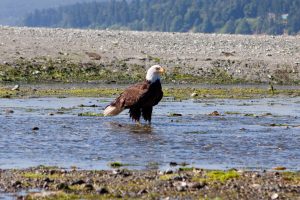
Climate change will have both direct and indirect impacts on wildlife in the Point No Point Treaty area. The indirect effects will occur primarily as a result of changes in habitat brought about by warming temperatures, changes in rainfall, and rising sea levels. At low elevations forests are likely to be slower growing, more open, and more vulnerable to frequent fires. Animals that depend on dense, moist forests with large trees may not be able to survive there. Riparian forests and their wildlife species are also expected to decline due to drier summers. Alpine areas will decline as warming allows forests to spread to higher elevations. This will adversely affect animals associated with alpine habitat, like Roosevelt elk and the rare Olympic marmot. Animals dependent on intertidal and shallow-water marine areas, such as shorebirds and waterfowl, will lose historic feeding areas as rising seas flood their habitat.
Warming will likely affect the timing of the life cycles of animals and plants. This may disrupt the historic coordination between the needs of animals and the availability of their food sources. For example, migratory birds and bats may arrive in spring before the insects they depend upon have emerged; bears may emerge from hibernation before spring food sources are available. Shifts in distribution or changes in populations could expose some species to competitors or predators they’ve never encountered before. For example, shorter winters and warmer summers could allow the coyote to expand its range into higher elevations, where it could have detrimental effects on animals that are not adapted to coyote predation.
Climate change may also have direct physiological effects on wildlife. Loss of special habitats or microclimates could expose animals to lethal temperatures. Warmer temperatures may disrupt hibernation, leading to increased energy demands and threatening the overwinter survival of animals like non-migratory bats, chipmunks, and marmots. Drier, hotter summers may lead to more rapid dehydration of animals, forcing them to expend additional energy to find sources of drinking water.
View more climate impacts